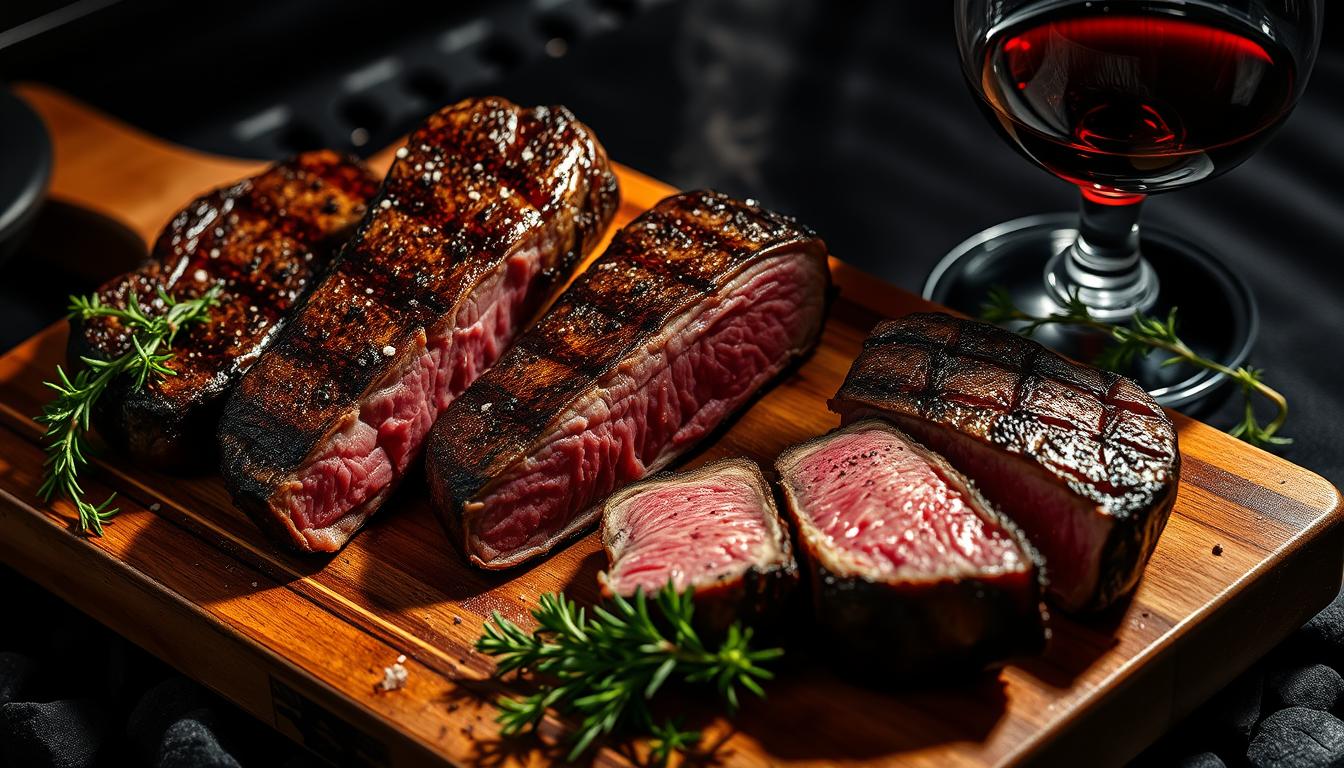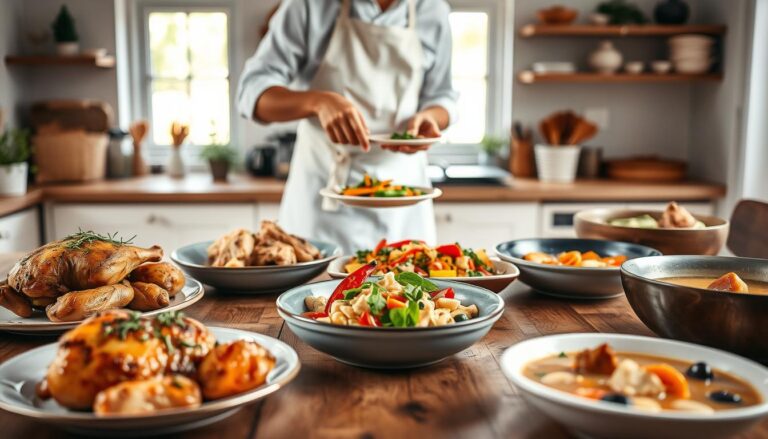How to Cook Beef Steaks Like a Pro: Foolproof Recipes and Grilling Secrets
The sizzle of beef steaks on a hot grill is my passion. I watched my grandfather turn simple cuts into amazing meals. These meals brought our family together, creating unforgettable memories.
Grilling secrets are not hard to learn. They are techniques anyone can master. This guide will teach you how to cook delicious beef steaks in your kitchen.
You’ll learn how to pick the best cut and get that perfect golden crust. Professional chefs have shared their secrets with you. Now, cooking steaks will feel easy.
Key Takeaways
- Understanding meat cuts dramatically improves steak quality
- Proper preparation is key for top-notch results
- Temperature control is essential for the right doneness
- Seasoning boosts the natural flavors of the meat
- Letting the meat rest after cooking keeps it juicy
Understanding Different Steak Cuts for Perfect Results
Choosing the right steak cut is key to a great meal. Not all steaks are the same. Knowing their differences helps you pick the best one for your dinner.
Each steak cut has its own flavor, tenderness, and cooking method. Learning about premium, value, and specialty cuts will improve your cooking. It ensures a tasty meal every time.
Premium Cuts: Ribeye and Filet Mignon
Premium steaks are the best of the best. The ribeye is known for its rich flavor and tender texture. It’s full of fat that makes it melt in your mouth.
Filet mignon, from the tenderloin, is the most tender. It has a light taste that’s hard to beat.
- Ribeye: Maximum marbling, robust flavor
- Filet Mignon: Most tender cut, lean profile
Value Cuts: Sirloin and Flat Iron
Steaks that are easy on the wallet can be just as tasty. Sirloin is a favorite for its good taste and price. The flat iron, from the shoulder, has a strong beef flavor and is tender.
| Cut | Flavor Profile | Price Range |
|---|---|---|
| Sirloin | Moderate beef flavor | $8-$12 per pound |
| Flat Iron | Rich, beefy taste | $6-$10 per pound |
Specialty Cuts: New York Strip and T-Bone
Specialty steaks have unique qualities that beef lovers enjoy. The New York strip is tender and flavorful. It has a firm texture and a rich taste.
T-bone steaks are a luxury. They combine the tenderloin and strip steak. This makes for a special dining experience.
- New York Strip: Balanced flavor and texture
- T-Bone: Two cuts in one, featuring strip and tenderloin
Pro tip: Always consider your cooking method and personal preference when selecting a steak cut.
Essential Equipment and Tools for Steak Preparation
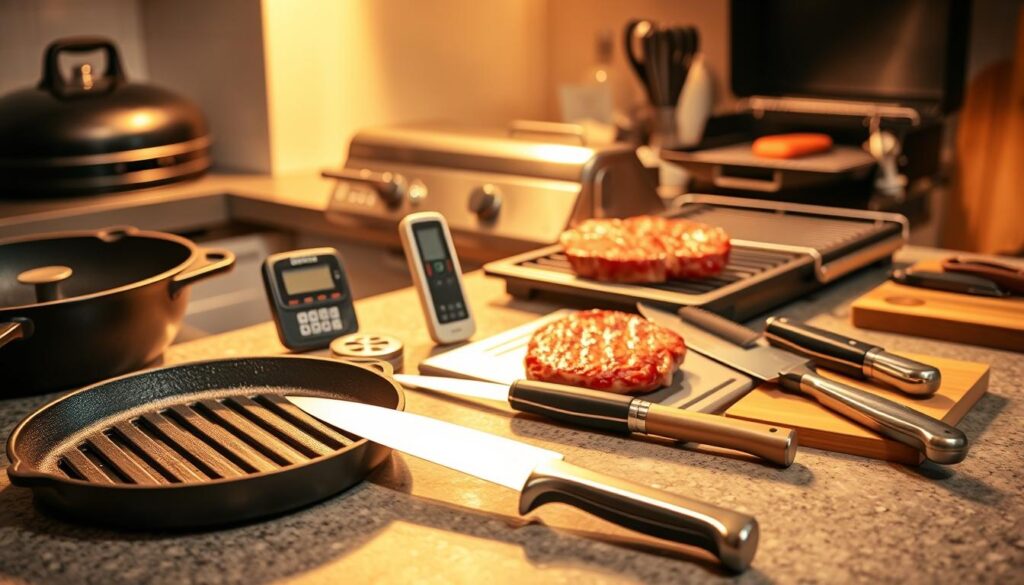
Getting the perfect steak is more than just good meat. The right tools can really make a difference. With the right equipment, you can make steaks as good as those in restaurants at home.
Your toolkit should have a few key items. A cast iron skillet is the best pan for a perfect sear. It holds heat well and cooks evenly, making a tasty crust that keeps the meat juicy.
- Cast iron skillet for perfect searing
- Accurate meat thermometer for precise doneness
- Long-handled tongs for safe meat handling
- Sharp chef’s knife for trimming
- Sturdy cutting board
A good meat thermometer is key for knowing when your steak is done. Digital models give quick and accurate readings. This tool helps you avoid overcooking and ensures your steak is just right.
Choose high-quality, durable tools for your steak equipment. Good tools last longer and work better. Taking care of them means they’ll help you make many more great steak dinners.
Proper Steak Temperature and Preparation Methods
Preparing the perfect steak starts long before cooking. The way you prepare your steak greatly affects its taste and texture. Professional chefs focus on details to make a steak at home taste like a restaurant’s.
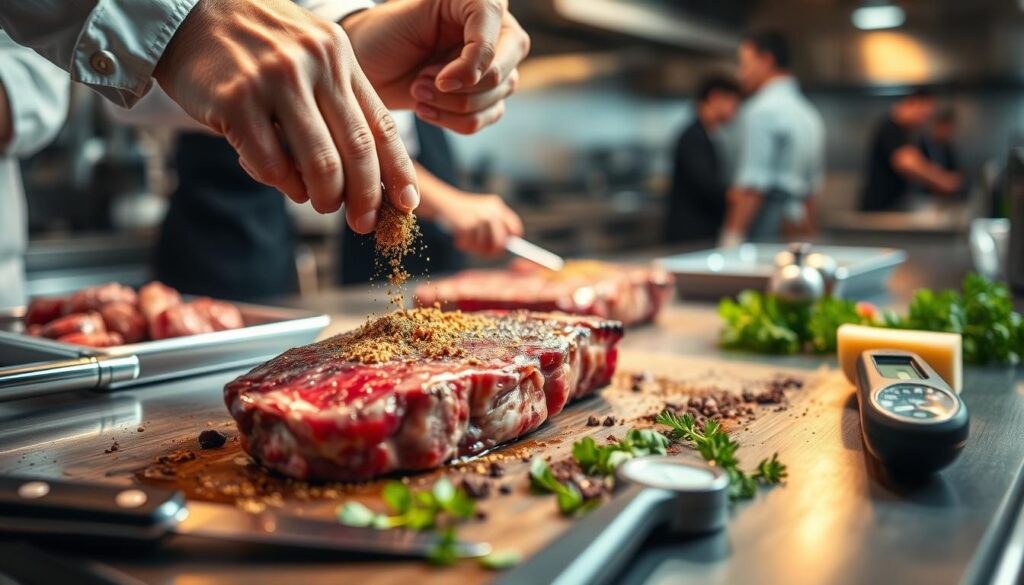
Preparing your steak involves key steps that turn a regular cut into a special meal. The right steps can make your cooking go from good to great.
Room Temperature Principles
Room temperature is key in steak prep. Steaks straight from the fridge cook unevenly. Experts say:
- Take steaks out of the fridge 30-60 minutes before cooking
- Let them sit at room temperature for even heating
- Ensure even cooking by letting the whole steak warm up slowly
Seasoning Techniques
Seasoning steak is an art that boosts beef flavors. Your method should be simple yet effective:
- Use coarse kosher salt for better flavor
- Apply freshly ground black pepper generously
- Pat the steak dry before seasoning for a perfect crust
Dry Brining Magic
Dry brining makes an average steak into a top-notch dish. This method involves salting the meat and letting it rest. It concentrates flavors and makes the steak tender. Sprinkle coarse salt and let it sit for 40-60 minutes for a juicier, tastier steak.
Your steak prep method is the base for a fantastic meal. Learning these techniques will boost your cooking skills and wow food lovers.
Tips for Searing the Best Beef Steak with a Perfect Crust
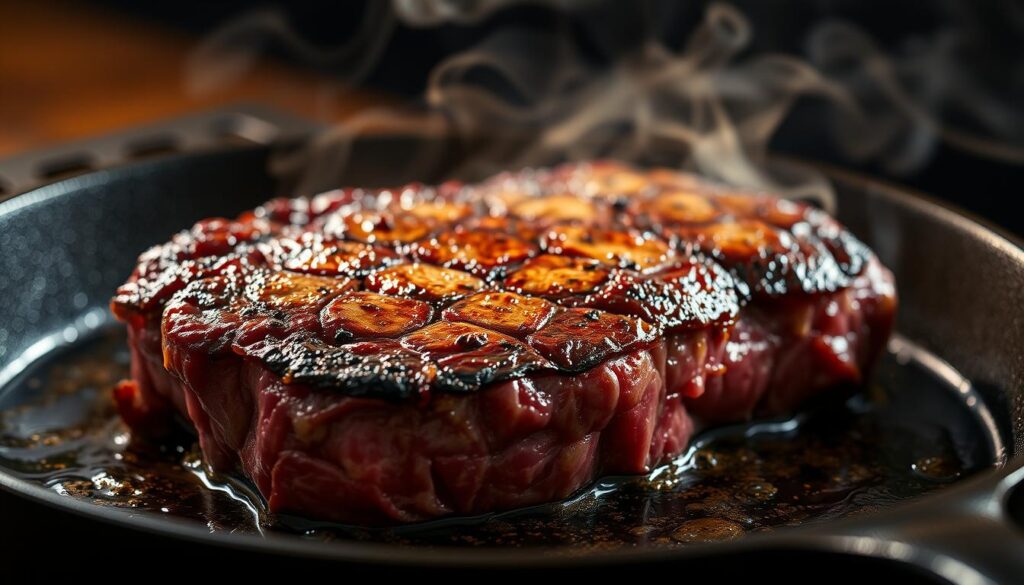
Creating a perfect crust is key to a great beef steak. Searing steak needs precise techniques to turn it into a top-notch dish. It’s all about how high heat works with the meat’s surface to bring out rich flavors.
Here are some important tips for searing your beef steak:
- Choose a heavy-bottomed cast-iron skillet for maximum heat retention
- Ensure the steak is completely dry before searing
- Heat the pan until it’s smoking hot
- Use high smoke-point oils like avocado or grapeseed
The Maillard reaction is what makes the crust perfect. It’s a chemical reaction that happens when amino acids and sugars meet. Don’t move the steak around – let it sit for 2-3 minutes on each side to get that golden-brown crust.
Timing is everything when searing steak. Don’t overcrowd the pan or move the meat too much. Press the steak gently with tongs to make sure it’s in full contact with the hot pan. You want a dark, crisp crust that keeps the steak’s juices inside.
Pro chefs say to let your steak come to room temperature before searing. This helps it cook more evenly and lets the seasonings soak in better. A light sprinkle of salt and pepper just before cooking will boost the steak’s flavor.
Mastering the Reverse Sear Method
The reverse sear method has changed how we cook steaks at home. It gives us better temperature control and consistent results. This method turns a simple steak into a gourmet dish, with perfect cooking from start to finish.
Both professional chefs and home cooks love this method for perfect steak doneness. It reduces the chance of overcooking. It also makes sure the inside is even and the outside is crispy.
Temperature Control Guidelines
When using the reverse sear method, controlling temperature is key. Cook the steak slowly at a low temperature first. Then, finish it with a high-heat sear. This method works well for all steak thicknesses.
- Preheat oven to 225-275°F
- Use a reliable meat thermometer
- Monitor internal meat temperature carefully
Step-by-Step Process
- Season steak generously with salt and pepper
- Place steak on a wire rack over a baking sheet
- Slow cook in oven until internal temperature reaches 10-15°F below target
- Sear in hot cast-iron skillet for 45-60 seconds per side
Timing and Doneness Levels
Knowing how to check for steak doneness is important. Different internal temperatures mean different levels of doneness:
| Doneness Level | Internal Temperature | Cooking Time |
|---|---|---|
| Rare | 125°F | 20-25 minutes |
| Medium Rare | 135°F | 25-30 minutes |
| Medium | 145°F | 30-35 minutes |
| Medium Well | 150°F | 35-40 minutes |
Remember, the thickness of the steak affects cooking time. Thicker cuts need longer slow cooking. Thinner steaks cook faster. With practice and patience, you’ll get better at reverse searing.
Butter Basting Techniques for Enhanced Flavor
Butter basting is a secret trick used by chefs to make a simple steak taste amazing. It creates a rich, flavorful coating that boosts the meat’s taste and feel.
To get good at butter basting, you need the right ingredients and some cooking skills. Here’s what to do first:
- Choose a high-quality butter with good fat content
- Select fresh herbs like thyme or rosemary
- Use a cast-iron skillet for best results
- Keep flame at medium-high heat
When it’s time to butter baste, add butter to your hot pan in the last minutes of cooking. Tilt the pan and keep spooning the melted, herb-infused butter over the steak. This method makes a golden-brown crust and adds deep flavors to the meat.
Experts say to use unsalted butter and add minced garlic for more flavor. Move fast and baste often to avoid burning the butter. Your aim is to get a shiny, tasty outside that keeps the steak’s juices in.
- Pro tip: Use a spoon with a long handle to safely baste
- Temperature matters: Keep butter at a gentle bubble, not scorching hot
Butter basting turns a regular steak into a top-notch dish at home. With practice, you’ll master this technique and elevate your steak game.
Internal Temperature Guide and Resting Times
Mastering the steak temperature guide is key to perfect doneness every time. Understanding internal temperatures and resting techniques can elevate your steak to restaurant quality.
Knowing the right internal temperatures is essential for cooking your steak just right. A reliable meat thermometer is your best tool for precise results.
Doneness Levels Temperature Chart
| Doneness Level | Internal Temperature | Appearance |
|---|---|---|
| Rare | 120°F-125°F | Cool red center |
| Medium Rare | 130°F-135°F | Warm red center |
| Medium | 140°F-145°F | Pink center |
| Medium Well | 150°F-155°F | Slight pink center |
| Well Done | 160°F+ | No pink |
Proper Resting Techniques
Resting steak is a critical step many home cooks miss. After removing the steak from heat, let it rest for 5-10 minutes. This allows:
- Juice redistribution throughout the meat
- Temperature stabilization
- More tender and flavorful results
Cover your steak loosely with aluminum foil during resting. This keeps it warm without trapping too much steam. The internal temperature will rise slightly, so remove the steak from heat just before it reaches your desired doneness.
Common Steak Cooking Mistakes to Avoid
Cooking the perfect steak needs skill and focus. Many home cooks make mistakes that can spoil a great steak. Knowing these common errors can help you improve your steak cooking and wow your guests.
Let’s look at the top steak tips to make your cooking better:
- Cold Meat Catastrophe: Never cook a steak straight from the fridge. Take it out 30-45 minutes before cooking. This lets it warm up evenly and get a perfect sear.
- Overseasoning Overload: Too much seasoning can hide the beef’s natural taste. Use kosher salt and freshly ground black pepper for the best flavor.
- Pan Panic: The wrong pan can ruin your steak. Use a cast iron skillet or heavy-bottomed pan for a golden-brown crust.
Practicing and being patient are key to avoiding these mistakes. Cutting into the steak too soon is a big error. Let it rest for 5-10 minutes to keep it tender and juicy.
- Prevent overcooking by using a meat thermometer
- Always pat your steak dry before searing
- Choose the right cooking method for your cut
Mastering steak cooking is an art. Every mistake is a chance to learn and get better. With these tips, you’ll soon be cooking steaks like a pro in your own kitchen.
Conclusion
Cooking the perfect steak is a mix of science, skill, and love. Now, you have the tips to make any steak special. Each steak is different, and you’ll get better with every try.
Practice is key to making steaks as good as those in restaurants. Whether it’s a fancy ribeye or a more affordable sirloin, you can make it great. It’s not just about following steps, but understanding the art of cooking meat.
Your cooking journey is just starting. Try new cuts, experiment with seasonings, and don’t worry about mistakes. Every chef began where you are, eager to learn. The fun of cooking is in always trying new things and getting better.
We want to hear about your steak adventures, both the good and the bad. Your story is important, and every steak has its own tale of taste, skill, and growth. Keep exploring, keep cooking, and enjoy every bite.

